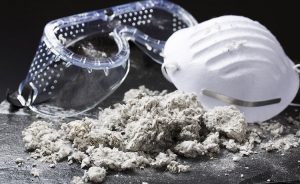
Asbestos Survey FAQs
Many buildings in the UK built prior to 2000 still contain asbestos-based materials. Since it’s not always possible to tell by looking (with asbestos resembling
Lead paint is one of several materials that have been banned in the UK because of the danger they pose to the public. A leading cause of lead poisoning in the country, these paints were removed from general sale in 1992. Some types of lead-based paint can still be bought, but only by licenced tradespeople for specific applications.
Of course, many older properties may still have lead paint on their walls, and this could present a possible health risk. In this article, we’re going to discuss the dangers of lead paint as well as two popular methods of dealing with it: lead paint removal and encapsulation.
The simple answer, of course, is that lead paint is paint with lead in it, but there’s a little more to it than that. Lead was included in paint for several reasons, including the following:
White lead (lead sulphate or lead carbonate) was added to many paint products as the primary white pigment. This type of paint was primarily used as a primer for wood and metal surfaces, including radiators, pipes, skirting boards, dado rails, doors and door frames, window sills and window frames, stairways, bannisters, and more.
Red lead (a name given to the pigments calcium plumbate and lead tetroxide) was added to paints for its anti-corrosive qualities, making it a popular choice for external metalwork such as gates and fences. It was not included in the 1992 ban and can still be purchased under licence.
Lead chromates were created in various hues to colour red, yellow, orange, and green paint products. While banned for all domestic and some commercial use, lead-based yellow paint is still used for road markings.
Lead naphthenate is a drying agent added to certain paints to ensure they dried in a particular way that would result in a hardened surface. While never officially banned, the inclusion of the substance was phased out in the 1960s.
As most of us know, lead is a toxic substance and can be poisonous to humans if swallowed or inhaled. It is this second method that concerns us here. An intact layer of lead paint is of no immediate danger. However, as it gets older, it tends to split, flake, and crumble to dust. This lead paint dust can easily be inhaled, resulting in lead poisoning. Removing the paint using regular methods can make things worse, as scrapers and burners simply release more poisonous lead dust into the air.
Lead is highly toxic and affects nearly every system in the body, including the central nervous system, kidneys, and blood cells. High levels of lead in the blood can result in severe neurologic problems, including seizures, comas, and even death.
Common symptoms include:
If your property has lead paint that is flaking and crumbling, you have two main options: lead paint removal or encapsulation. Both have their positives and negatives, which we hope to demonstrate here.
There are several ways to remove lead paint. These include liquid paint removers that bind the paint fragments to prevent flaking, electric sanders equipped with a HEPA (High Efficiency Particulate Air) filtered vacuum, or hand scraping with a low-temperature heat gun.
Whichever method you choose, lead paint removal is often the best choice in the long term. It’s a permanent fix, so you don’t have to worry about facing the problem again later down the line. In almost every situation involving lead paint, it is the most effective solution.
Of course, lead paint removal takes longer than encapsulation and is more expensive. Once it’s done, however, you won’t need to do it again, as you might with encapsulation. Lead paint removal also requires more extensive safety measures to protect anyone in the vicinity from lead paint inhalation during the process, as well as more training for the technicians doing the work.
Lead paint encapsulation involves applying a specially formulated coating to the affected area. This coating forms a watertight bond, sealing the flaking lead paint in place and covering it with a protective layer.
There are several benefits to lead paint encapsulation. It is typically cheaper and quicker than the lead paint removal process, meaning less downtime in a commercial environment and less disruption in a home or domestic setting. It’s also safer for the technicians to complete, with less risk.
However, lead paint encapsulation is not a permanent solution. Over time, the coating will erode (just like the paint it is covering) and will need to be reapplied. It can be a useful stop-gap if you currently lack the funds for a full lead paint removal. Also, lead paint encapsulation cannot be used in all cases. If the base paint is particularly corroded, encapsulation will not be an effective remedy.
As lead control professionals, we would always recommend lead paint removal over lead paint encapsulation. While it may be more costly in terms of money, time, and resources, it is the only way to permanently eliminate the risk of lead paint poisoning. Really, lead paint encapsulation should only be considered as a stop-gap measure, with a view to full lead paint removal later down the line.
Based in Basildon, we provide reliable lead paint control services across the UK. These include detailed lead paint surveys to determine the extent of the problem, as well as lead paint encapsulation and, of course, lead paint removal. If you’re concerned about lead paint on your property and need experts to deal with it, contact Abastra Environmental Ltd today on 01268 411 355c

Many buildings in the UK built prior to 2000 still contain asbestos-based materials. Since it’s not always possible to tell by looking (with asbestos resembling

Although banned in the UK since 2000, asbestos was a common building material well into the 1980s, meaning many properties are likely to have some
| Cookie | Duration | Description |
|---|---|---|
| cookielawinfo-checkbox-analytics | 11 months | This cookie is set by GDPR Cookie Consent plugin. The cookie is used to store the user consent for the cookies in the category "Analytics". |
| cookielawinfo-checkbox-functional | 11 months | The cookie is set by GDPR cookie consent to record the user consent for the cookies in the category "Functional". |
| cookielawinfo-checkbox-necessary | 11 months | This cookie is set by GDPR Cookie Consent plugin. The cookies is used to store the user consent for the cookies in the category "Necessary". |
| cookielawinfo-checkbox-others | 11 months | This cookie is set by GDPR Cookie Consent plugin. The cookie is used to store the user consent for the cookies in the category "Other. |
| cookielawinfo-checkbox-performance | 11 months | This cookie is set by GDPR Cookie Consent plugin. The cookie is used to store the user consent for the cookies in the category "Performance". |
| viewed_cookie_policy | 11 months | The cookie is set by the GDPR Cookie Consent plugin and is used to store whether or not user has consented to the use of cookies. It does not store any personal data. |